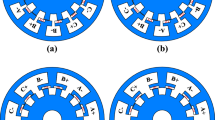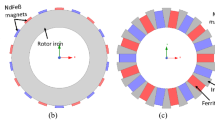Abstract
This paper presents a two-dimensional analytical model for brushless double-rotor flux-switching permanent magnet machines (BDRPFSPMM) with yokeless stator recognized as a type of partitioned-structure flux-switching permanent magnet that is an appropriate machine to be employed as the electric motor in industry. The most salient advantages of the proposed machine are low iron loss due to volume of iron in stator and high space of stator slot for winding. The radial and tangential components of the magnetic flux density due to permanent magnets and armature currents in each active domain of the machine, electromagnetic torque, self- and mutual inductance, unbalanced magnetic force (UMF), and local traction are calculated based on the subdomain method. Teethes on both rotor and stator structures are effective on magnetic quantities, so interactions of rotor and stator saliency are considered. The method is general for the magnetic field calculation with any combination of rotor- and stator-pole number. To validate the proposed model, the analytical outputs are compared with those obtained from the finite element method (FEM).















Similar content being viewed by others
Availability of data and materials
No datasets were generated or analyzed during the current study.
Abbreviations
- A:
-
Magnetic vector potential (V.s/m)
- B:
-
Magnetic flux density vector (T)
- B rem :
-
Permanent magnet residual flux density (T)
- Br :
-
Radial component of B (T)
- B t :
-
Tangential component of B (T)
- H:
-
Magnetic field intensity vector (A/m)
- H t :
-
Tangential component of H (T)
- J:
-
Armature current density vector (A/m2)
- M:
-
Magnetization vector (A/m).
- μ 0 :
-
Free space permeability (H/m)
- μ r :
-
Relative permeability
- μ rpm :
-
Relative permeability of permanent magnet
- N ss :
-
Number of stator slots
- N irs :
-
Number of inner rotor slots
- N pm :
-
Number of permanent magnets
- N ors :
-
Number of outer rotor slots
- α i :
-
Central angle of ith slot of inner rotor
- β i :
-
Central angle of ith slot of stator
- λ i :
-
Central angle of ith PM
- σ i :
-
Central angle of ith slot of outer rotor
References
Cao R, Yuan X, Jin Y, Zhang Z (2019) MW- Class Stator Wound Field Flux-Switching Motor for Semi-Direct Drive Wind Power Generation System. IEEE Trans Industr Electron 66(1):795–805
Yıldırız E, Güleç M, Aydın M (2018) An innovative dual-rotor axial-gap flux-switching permanent-magnet machine topology with hybrid excitation. IEEE Trans Magn 54(11):8107705
Mo L, Zhu X, Zhang T, Quan L, Lu Q, Bai X (2018) Loss and efficiency of a flux-switching permanent-magnet double-rotor machine with high torque density. IEEE Trans Magn 54(11):8106705
Cheng M, Hua W, Zhang J, Zhao W (2011) Overview of stator permanent magnet brushless machines. IEEE Trans Ind Electron 58(11):5087–5101
Xiang Z, Quan L, Zhu X, Wang L (2015) A brushless double mechanical ports permanent magnet motor for plug-in HEVs. IEEE Trans Magn 51(11):8111
Dupas A, Hlioui S, Hoang E, Gabsi M, Lecrivain M (2015) Investigation of a new topology of hybrid-excited flux-switching machine with static global winding: experiments and modeling. IEEE Trans Ind Appl 52(2):1413–1421
Li S, Li Y, Sarlioglu B (2015) Partial irreversible demagnetization assessment of flux-switching permanent magnet machine using ferrite permanent magnet material. IEEE Trans Magn 51(7):8106209
Ullah W, Khan F, Sulaiman E, Sami I, Ro J (2020) Analytical sub-domain model for magnetic field computation in segmented permanent magnet switched flux consequent pole machine. IEEE Access 9:3774–3783
Cao R, Jin Y, Zhang Y, Cheng M (2016) A new double-sided HTS flux-switching linear motor with series magnet circuit. IEEE Trans Appl Superconduct 26(7):5207405
Du Y, Zou C, Zhu X, Zhang C, Xiao F (2016) A full-pitched flux-switching permanent magnet motor. IEEE Trans Appl Superconduct 26(4):0604505
Zhang J, Cheng M, Chen Z, Hua W (2009) Comparison of stator mounted permanent-magnet machines based on a general power equation. IEEE Trans Energy Convers 24(4):826–834
Mo L, Zhu X, Zhang T, Quan L, Lu Q, Bai X (2018) Loss and efficiency of a flux-switching permanent-magnet double-rotor machine with high torque density. IEEE Trans Magn 54(11):8106705
Yıldırız E, Güleç M, Aydın M (2018) An innovative dual-rotor axial-gap flux-switching permanent-magnet machine topology with hybrid excitation. IEEE Trans Magn 54(11):8107705
Zhou LK, Hua W, Cheng M (2017) Analysis and optimization of key dimensions of co-axial dual-mechanical-port flux-switching permanent magnet machines for fuel-based extended range electric vehicles. CES Trans Electr Mach Syst 1(3):292–299
Xiang Z, Quan L, Zhu X, Huang J, Fan D (2018) Investigation of Optimal Split Ratio in Brushless Dual-Rotor Flux-Switching Permanent Magnet Machine Considering Power Allocation. IEEE Trans Magn 54(3):8102104
Wu Z, Zhu Z (2015) Analysis of air-gap field modulation and magnetic gearing effects in switched flux permanent magnet machines. Magn IEEE Trans Magn 51(5):8105012
Hua W, Zhang G, Cheng M (2015) Investigation and design of a high-power flux-switching permanent magnet machine for hybrid electric vehicles. IEEE Trans Magn 51(3):8201805
Dai M, Quan L, Zhu X, Xiang Z and Zhou H (2014) Design of a sandwiched flux switching permanent magnet machine with outer-rotor configuration. In: 2014 IEEE conference and expo transportation electrification Asia-Pacific (ITEC Asia-Pacific), article number: 14711707
Boughrara K, Lubin T, Ibtiouen R (2013) General subdomain model for predicting magnetic field in internal and external rotor multiphase flux switching machines topologies. IEEE Trans Magn 49(10):5310–5325
Gysen BLJ, Ilhan E, Meessen KJ, Paulides JJH, Lomonova EA (2010) Modeling of flux switching permanent magnet machines with Fourier analysis. IEEE Trans Magn 46(6):1499–1502
Yu D, Yun CY, Lin YL (2017) Design and comparison of double-stator and conventional flux switched permanent magnet motor. In: 2017 20th international conference on electrical machines and systems (ICEMS)
Yang H, Lin H, Li Y, Wang H, Fang S, Huang Y (2018) Analytical modeling of switched flux memory machine. IEEE Trans Magn 54(3):810180
Ilhan E, Gysen BLJ, Paulides JJH, Lomonova EA (2010) Analytical hybrid model for flux switching permanent magnet machines. IEEE Trans Magn 46(6):1762–1765
Gysen BLJ, Ilhan E, Meessen KJ, Paulides JJH, Lomonova EA (2010) Modeling of flux switching permanent magnet machines with fourier analysis. IEEE Trans Magn 46(6):1499–1502
Gaussens B, Hoang E, de la Barriere O, Saint-Michel J, Gabsi M (2012) Analytical approach for air-gap modeling of field-excited flux-switching machine: no-load operation. IEEE Trans Magn 48(9):2505–2517
Yang H, Lin H, Li Y, Wang H, Fang S, Huang Y (2018) Analytical modeling of switched flux memory machine. IEEE Trans Magn 54(3):8101805
Yu J, Liu C, Song Z, Zhao H (2020) Permeance and inductance modeling of a double-stator hybrid-excited flux-switching permanent magnet machine. IEEE Trans Transp Electrific 6(3):1134–1145
Boughrara K, Lubin T, Ibtiouen R (2013) General subdomain model for predicting magnetic field in internal and external rotor multiphase flux-switching machines topologies. IEEE Trans Magn 49(10):5310–5325
Xiang Z, Zhu X, Quan L, Du Y, Zhang C, Fan D (2016) Multilevel design optimization and operation of a brushless double mechanical ports flux-switching permanent magnet motor. IEEE Trans Ind Electr 63(10):6042–6054
Ullah W, Khan F, Sulaiman E, Sami I, Ro J (2020) Analytical sub-domain model for magnetic field computation in segmented permanent magnet switched flux consequent pole machine. IEEE Access 9:3774–3783
Funding
This research received no specific grant from any funding agency in the public, commercial, or not-for-profit sectors.
Author information
Authors and Affiliations
Contributions
ES that simulation and novelty has been done by him and initial writing and sentencing is on him. HMP and MTS only works on correcting sentencing.
Corresponding author
Ethics declarations
Competing interests
The authors declare no competing interests.
Conflict of interests
This research is sponsored by [Bojnourd University] and may lead to development of products.
Ethical approval
I hereby declare that this thesis represents my own work which has been done after studying at university of Bojnourd and has not been previously included in a thesis or dissertation submitted to this or any other institution for a degree, diploma, or other qualifications. I have read the research ethics guidelines and accept responsibility for the conduct of the procedures in accordance with Springer journal. We confirm that we have given due consideration to the protection of intellectual property associated with this work and that there are no impediments to publication, including the timing of publication, with respect to intellectual property. In so doing, we confirm that we have followed the regulations of our institutions concerning intellectual property. We further confirm any aspect of the work covered in this manuscript that not has involved either experimental animals or human patients. We understand that the Corresponding Author is the sole contact for the Editorial process (including Editorial Manager and direct communications with the office). We confirm that we have provided a current, correct email address which is accessible by the Corresponding Author.
Additional information
Publisher's Note
Springer Nature remains neutral with regard to jurisdictional claims in published maps and institutional affiliations.
Appendix
Appendix
The expressions for calculating the coefficients are as follows:
Rights and permissions
Springer Nature or its licensor (e.g. a society or other partner) holds exclusive rights to this article under a publishing agreement with the author(s) or other rightsholder(s); author self-archiving of the accepted manuscript version of this article is solely governed by the terms of such publishing agreement and applicable law.
About this article
Cite this article
Shirzad, E., Pirouz, H.M. & Shirzad, M.T. Subdomain method for brushless double-rotor flux-switching permanent magnet machines with yokeless stator. Electr Eng 106, 1475–1485 (2024). https://doi.org/10.1007/s00202-023-01795-6
Received:
Accepted:
Published:
Issue Date:
DOI: https://doi.org/10.1007/s00202-023-01795-6




